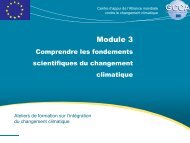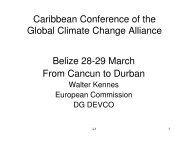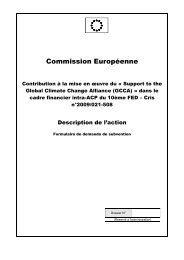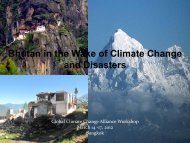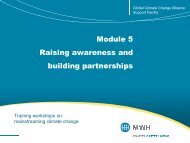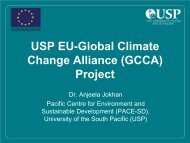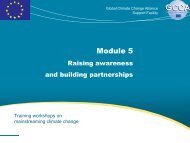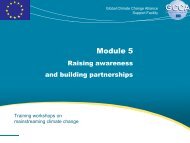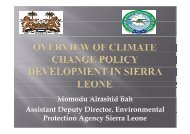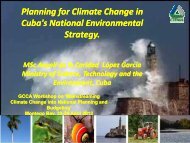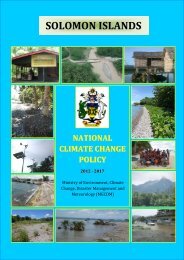Rwanda Green Growth Strategy 18nov11 - Global Climate Change ...
Rwanda Green Growth Strategy 18nov11 - Global Climate Change ...
Rwanda Green Growth Strategy 18nov11 - Global Climate Change ...
Create successful ePaper yourself
Turn your PDF publications into a flip-book with our unique Google optimized e-Paper software.
Chapter 5RMSREMAresearchinstitutionsCentre for<strong>Climate</strong>Knowledge forDevelopmentTechnical Co-ordinatingCommitteeChair: MINECOFIN andMINIRENAFONERWAChair: MINECOFINMINECOFIN - MINIRENA - MININFRA - MINAGRI - MIDIMAR - MINICOM - MINEDUC - MOH - MINALOCAuthorities and AgenciesRRA - RNRA - EWSA - RTDA - RHA - PSF - RDBSub-national forumsCouncils - IDP - JADFFigure 13: Institutional arrangements for climate-related strategy and policy developmentThe Technical Coordinating Committee will facilitate the flow of knowledge between the Centre for<strong>Climate</strong> Knowledge for Development, RMS, REMA <strong>Climate</strong> <strong>Change</strong> Unit, academic institutions and theMinistries and their sub-sectors and sub-national committees and forums. The Technical CoordinatingCommittee will oversee the Technical Committee for FONERWA and for CCKD.The institutional arrangement will facilitate mainstreaming of climate resilience and low carbondevelopment into Vision 2020, EDPRS, national sector strategies and policies, and budgeting and planningprocedures. Mainstreaming into policy and planning is equally important at the sub-national to ensure thatlocal needs are being met and that communities receive incentives for their efforts. This would includeDistrict councils, the Integrated Development Programme (IDP), the Joint Action Development Forum(JADF) and Community Development Councils. Participatory action planning should be used to developlocal plans so that community voices are heard and have ownership.Centre for <strong>Climate</strong> Knowledge for DevelopmentIn order to respond and adapt to climate change, robust climate data and projections are required.But even more important is the ability to translate the information into sector-specific knowledge and policyoptions for decision makers. This currently does not exist at the level required to achieve the objectives ofthe <strong>Strategy</strong> and enable <strong>Rwanda</strong> to respond to change on an ongoing basis. The building blocks necessaryto do this are shown in Figure 14 which shows how they build upon each other. Although the buildingblocks are being addressed to some degree in <strong>Rwanda</strong>, greater coordination is required.RMS is responsible for the station network, data-related activities, seasonal outlooks and climateprojections, and has made significant progress in recent years. MINAGRI and the MOH have stationnetworks and MINAGRI produces seasonal outlooks. The Kigali Institute of Science and technology (KIST)and the National University of <strong>Rwanda</strong> (NUR) are planning to establish geosciences courses and a climateobservatory on Mount Karisimbi is planned together with the Common Market for Eastern and SouthernAfrica (COMESA), which will monitor regional atmospheric GHG constituents and build local capacity,amongst other activities [14] . MIDIMAR, RMS and MINALOC are planning on developing early warningsystems (EWS) while the REMA <strong>Climate</strong> <strong>Change</strong> Unit performs the assessment of climate sensitivities andadaptation and mitigation policy options. A detailed table of current activities and stakeholders and a gapanalysis is found in Table 2 in Appendix F.28Government of <strong>Rwanda</strong>




